Register for our annual NDP Celebrations for 2014
Date 9 August, Time: 4pm – 7pm
Meeting place : Gates of Lorong Halwa, where we will begin by taking a group photo.
We have 3 Guided Walks which will all start at 4 pm at the gates
1 )Fabian and Simone will retrace the steps of men and women who broke traditions, defied the odds, dared fate and thereby defined an era and shaped the destinies of many
2) Bianca and Claire takes you on a poetic trail on the life and times of some Bukit Brown residents.
3) Mandarin Tour by Walter Lim, please click on link to register.
https://www.facebook.com/events/1446774978918007
The Brownies will lead you to the spot for collecting goody bags, and observing the National Anthem and The Pledge at the end of the guided walk. The programme after the walks will include quizzes and ad hoc singing, in conviviality and camaraderie.
NDP ’14 (Nations Deceased Pioneers) @ Bukit Brown this year honours the “can do” and caring spirit of our pioneers who helped to forge bonds which built the foundations for SG 50. It is the story of how “Our People” in Bukit Brown made Singapore, “Our Home”.
Please help us prevent wastage in preparing for food and ensure we have goody bags for everyone by registering here early so we can capture numbers early. Register by 6 August by clicking “join” . You may also register friends or family who are not on FB by leaving a comment on how many will be coming in this blog post.
FB registration here
If you are not on FB, you can register here by leaving a comment with your name if you would like to attend with your name and number of people who are coming with you.
————————–
Bring a torch light, as light will fade to night over the course of the celebrations. Please remember bring umbrella or poncho protect yourself against the sun with sunscreen and avoid donating blood to the mozzie brigade with.mosquito repellent.
We will celebrate regardless of rain, sun or exhumations
Disclaimer: By agreeing to take walking tours of Bukit Brown Cemetery, I understand and accept that I must be physically fit and able to do so.To the extent permissible by law, I agree to assume any and all risk of injury or bodily harm to myself and persons in my care (including child or ward) Please read if you are attending our guided walks for the first time, useful info on safety : Getting There/游览信息 If you have a facebook account please register on the FB links provided unless otherwise stated
Previous NDP reports :
Bukit Brown : Documenting New Horizons of Knowledge
Location: NLB 9th floor from now until 10 October’14 and thereafter it will travel to other regional libraries.
The exhibition was officially opened on Saturday 19 July,2014 by MOS (Ministry of National Development) Desmond Lee.
It represents almost one and half years of research and working the ground documenting some 4,153 tombstones which are affected by the building of a new highway across Bukit Brown, by a team under the leadership of Dr. Hui Yew-Foong, an anthropologist with ISEAS.
We have observed the team hard at work over these years, joined some of them during Qing Ming and exhumations as observers and friends of the family of descendants, and the exhibition is a comprehensive and compact expression of what they have uncovered, shared with the public with insight and interesting artefacts , enhanced by new technology. We recommend it as a “must see” and “ground breaking” for insights shared of customary practices and traditions of burial customs and respect for ancestors.
An extract from the media release:
Documenting New Horizons of Knowledge” assembles a diverse range of documents,maps, photographs and objects to demonstrate how a cemetery can open a window to Singapore’s historical past and cultural present. Through a multi-disciplinary approach employing cutting-edge methods, techniques and technology, the exhibition will bring to the fore new horizons of knowledge unveiled through the documentation of Bukit Brown.
The exhibition opens with the origins of the cemetery, as a project of the Municipal Commissioners in early 20th in 1973, will be illustrated through maps and aerial photographs. Next, through explication of tomb inscriptions, tomb typology and the material culture of the cemetery, the exhibition will demonstrate Singapore’s connectivity to the region, China and the world.
While the cemetery is a burial space for the dead, it is also a space for the living at different points of Singapore’s history and ritual calendar. This will be illustrated through the life of kampongs that used to be situated in the vicinity of the cemetery and the life of the cemetery during Qing Ming and the Seventh Month Hungry Ghost Festival.
As data for the graves was collected and organised within a Geographic Information System (GIS) framework, the exhibition will present a Centrepiece where visitors will be able to access data related to specific graves through a map-based database on a touch screen monitor.
Finally, visitors will get a glimpse behind the scenes of documentation work, to get a sense of the different methods, techniques and technologies that were employed in the course of documentation. These range from balloon photography to 3D scanning, from interviewing to filming, and from the work of architects to the work of archaeologists.
****
Highlights of the Exhibition Opening
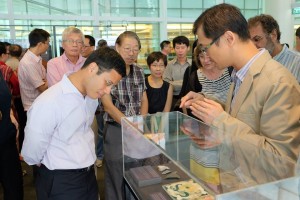
Dr Hui Yew-Foong, explaining material culture to MOS Desmond Lee during the curator’s walk through (photo Ang Hock Chuan)
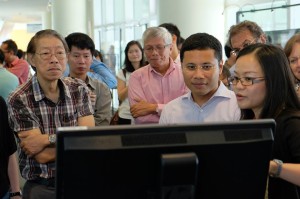
Dr. Natalie Pang (NTU) who worked on the IT applications for the centerpiece map demonstrating how it works to MOS Desmond Lee (photo Ang Hock Chuan)

The urn which used to house re-interred remains from other cemeteries to Bukit Brown (photo Raymond Goh)
This urn was used to re-inter bones exhumed from an older cemetery. It was from the grave of Madam Khoo Siok Hui, who died in 1836. Her grave was the oldest among those documented at Bukit Brown. Madam Khoo and her son Chee Yam Chuan were among the early settlers of Singapore. Mr Chee later returned to Malacca and made his fortune in tin mining in Selangor. Today, the Chee Yam Chuan Temple Trust continues to flourish in Malacca and Madam Khoo’s ancestral tablet can be found in the temple. The story behind this family shows the close links between Malacca and Singapore in the early years. It was Raymond Goh who first deciphered the inscription and unraveled the connection.

Treasure trove of jade bracelets worn by the women and traditionally buried with their wearers. (photo Ang Hock Chuan)
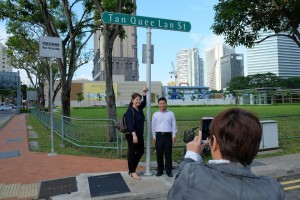
Descendant Serene Tan of pioneer Tan Quee Lan, gets one for the album when MOS Desmond Lee sportingly agrees to walk with her to visit her “great great grandfather’s road” ( photo Ang Hock Chuan)
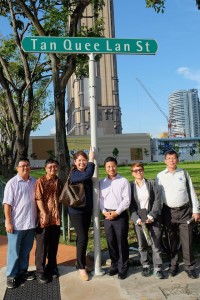
They were accompanied by a entourage of brownies who have been sharing Serene’s journey of reconnecting with her ancestors since Raymond Goh found the Tan Quee Lan cluster re-interred from another cemetery at Bukit Brown (photo Ang Hock Chuan)
A video at the exhibition features Serene Tan and her family observing the first Qing Ming at Bukit Brown in 2012 after Raymond Goh discovered the cluster of Tan Quee Lan tombs, and shows how the cluster underwent a renovation makeover by Serene and her cousin LT Tan who met at Bukit Brown itself. Serene’s story can be read here
The cluster is not affected by highway.
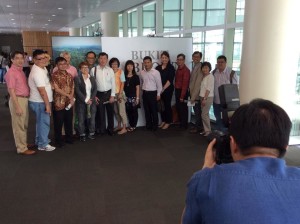
Brownies, academics, descendants, members of the documentation team at the exhibition (photo Khoo Ee Hoon)
“….to everyone who came and supported the launch, and most importantly, supported us and helped us generously with our research over the last 33 months. One of the purposes of the exhibition is to acknowledge all your contributions and I hope it accomplished that.” Dr Hui Yew- Foong, Curator of Exhibition on a FB posting.
Look out for 2 specially curated walks by the Brownies in conjunction with the exhibition in August (English) and September (Mandarin).
Photos taken of the exhibition courtesy of Brownie Ang Hock Chuan on Facebook here
Read more about the exhibition by the Rojak Librarian here
Disclaimer: By agreeing to take walking tours of Bukit Brown Cemetery, I understand and accept that I must be physically fit and able to do so.To the extent permissible by law, I agree to assume any and all risk of injury or bodily harm to myself and persons in my care (including child or ward) Please read if you are attending our guided walks for the first time, useful info on safety : Getting There/游览信息 If you have a facebook account please register on the FB links provided unless otherwise stated. There is also a walk by post museum in the after, please see details below for registration.
For all walks:
Please bring umbrella or poncho and sun protection.
Please wear covered footwear.
Please bring mosquito repellent.
Please bring sufficient drinking water.
Meeting place for all Walks : At the Lor Halwa Main gates at Bukit Brown
Sat 26 July’14 : 6.30pm – 8.30pm : A Journey into the Past with Andrew Lim
Follow Andrew for an evening stroll through Bukit Brown cemetery where he will share stories of the Past. We will go to a “mystery” location if time permits.
PLEASE BRING TORCH LIGHTS FOR THIS WALK
FB registration here
Mon 27 July’14: 9am – 11.30 am: Peranakan Tile Appreciation with Victor Lim
Join Victor Lim on his tour through the cemetery where he will focus on the various tiles used in the tomb designs.
Learn more about “Peranakan” or majolica tiles from our tiles expert!
FB registration here
Read more about the tiles here
by Joshua Ng
Instead of enjoying a quiet and uneventful Saturday, I chose to spend it at a live tomb measurement exercise. Armed with a trusty can of mosquito repellent, jeans and covered shoes, I arrived at the Bukit Brown Main Gate at 3.30pm. It was 35 degrees Celsius and I started to doubt my decision.
After a round of introductions, I was assigned to a team with Wei Ming (the drawing maestro), Andrew and Simone who are Brownies (volunteer guides). We had met briefly during the previous week’s theory and briefing workshop at NLB.
Our assigned tomb was Tan Ean Kiam’s wife, Ye Yan Niang (葉焉娘). Our task was to measure and draw the front view, section view and the plan view of the tomb.
Initially I was wondering why we needed four people to measure a tomb. It only made sense when we began our work. The curves, elevation and non-rectilinear structure makes it really hard to get an accurate reading. We had to use strings, bamboo sticks, IKEA flexible paper rulers, a metal tape measure as well as insect repellent to get it done.
The little insects that make their homes around the tomb were not amused — I even got a few ant bites on my hands. Some even crawled up my covered shoes and jeans and bit my calves.
Thankfully, after three hours of hard work, we finally finished our sketch. Our drawings were not the best. We committed at least one mistake, which was to assume that the sides are mirror images of each other. Chee Kien told us that we should not assume but measure and draw the tombs just as they are found. He pointed out that sometimes in a “couple” tomb, part of the tombs may be intentionally elevated so that the “water” will flow towards the descendants of one side.
This is not the first insight I gained from these two weeks of tomb measuring. I also learned that the different dialect groups have very different tomb designs. The one we measured clearly had a Hokkien design. Besides that, only the tombs in Bukit Brown have special bricks backing behind the head stone. It would have been very expensive to import bricks from China, so brick making was one of the earliest industries in Singapore.
As our assigned tomb was Tan Ean Kiam‘s wife, I figured he must have been some important person. I looked him up and found out that he was one of the founding members of OCBC Singapore. And he was also one of the founding members of the Tong Meng Hui (同盟会), which supported Sun Yet Sen’s revolutionary effort.
Another unique feature of this tomb is that the history of Mrs Tan was written by Tan Ean Kiam himself. According to the Brownies, Tan Ean Kiam’s own handwriting was inscribed on the body of the pedestal altar. Other than the fact that Tan Ean Kiam was alive when his wife passed away, we also know that he must have loved his wife a lot to do something so unusual as to personally inscribe her life story.
What amazed me the most is the fact that such a simple exercise like tomb measuring could connect the dots in my understanding of those who went before me. It makes me wonder what interesting facts I can discover from my grandparents’ tomb. Qing Ming (清明) would have been more fun if we were told about all these unique cultural factoids.
Mrs Tan’s tomb is just one tomb. There are about 4,000 tombs that are going to be destroyed without proper measurement and documentation because of the building of a highway that will cut Bukit Brown into half. Who knows what other important life insights we might have missed by not preserving and treasuring the stories of those who went before us.
There are 100,000 graves at Bukit Brown. Imagine how much time and effort will be needed to document them all. And as a digital heritage enthusiast, I can’t help but wonder if there could be better and faster ways to do this. Looks like my journey have just begun.
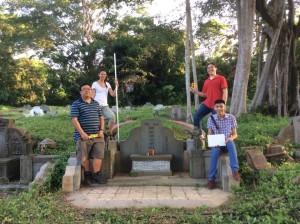
One for the album with the full team. Andrew on the left , Simone, Joshua and Wei Ming with his drawing, (photo Ee Hoon)
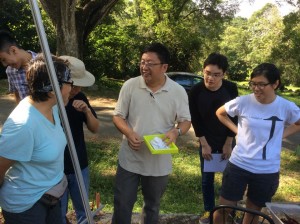
Dr Lai Chee Kien (third from left) sharing a light- hearted moment with his students (photo Ee Hoon)
***
Editors note
Documenting and taking precise measurements provide valuable data to analyze the proportions and variations through IT applications and ultimately relate it to Feng Shui. Tombstones are not just built, they are “feng shui’ed” Citizenry participation in a project like this is crucial because of the sheer size of Bukit Brown and because it signals a deeper engagement of ordinary people in wanting to understand all aspects of Bukit Brown. So kudos to Lai Chee Kien for this initiative and the first batch of participants for signing up. Hopefully there will be more.
What the tomb measurement workshop covered here.
For the first time Bukit Brown has been included in the Singapore HeritageFest with partners Singapore Heritage Society.
The walks are free but registration is needed via the Festival website only here
Registration opens 1 July, 2014. Spaces are limited so register early to avoid disappointment!
Bukit Brown in the City
Saturday July 19 & July 26, 4pm – 6.30pm
A number of pioneering settlers of 18th and 19th century colonial Singapore who were buried in the Chinese cemeteries of the Greater Bukit Brown Complex (including the first Chinese Municipal Cemetery) are today still remembered by streets and buildings bearing their name.
The activities and efforts of these movers and shakers – many of whom were members of leading Chinese families in other contemporary European colonies – contributed significantly to colonial Singapore’s transformation, from a regional entrepot port to a modern and globally significant trade and finance hub, the enterprise envisaged at its founding in 1819![]()
“Bukit Brown in the City” , takes you on a guided walk that covers Raffles Place; Boat Quay; Chulia Street (formerly Kling Road); Phillip Street; Telok Ayer Street; Club Street and eventually ending at Bukit Pasoh Road. Experience what life was like and what has changed over the years in old downtown Singapore.
The City in Bukit Brown
Sunday July 20th & 27th, 9am – 11.30am
Between 1922 and the period of the Second World War, a majority of the Chinese residents of Singapore were buried in Bukit Brown cemetery. Some of those buried here, were well-known and distinguished pioneers like Tan Ean Kiam; Gan Eng Seng; Tan Chor Nam; Lim Chong Pang; Tan Kheam Hock; Ong Sam Leong; Tan Boo Liat; See Tiong Wah – and they were leading contributors to the economic, social as well as cultural life of Singapore.
With “City in Bukit Brown”, we invite you to join the “Brownies” who will introduce you to the tombs of these prominent pioneers who landmarked street names and places all over Singapore. Listen to accounts of their lives, their fascinating backgrounds and the endearing legacies they handed down to our generation today.”
*****************************************************************************
About the Guides:
Alex Tan Tiong Hee, “Curator” and lead guide of “Bukit Brown in the City”
Alex, who studied law in England, was brought up on the lap of history. He was very close to his father, the late Tan Yeok Seong, who was a historian and scholar, as well as a publisher of educational textbooks for schools in Singapore. From his father was nurtured, an acute appreciation for the colonial history of Singapore vis-a-vis developments in China at that time Alex, lends to this heritage walk, his personal experience of historical places and the pioneers who are buried in Bukit Brown. Alex is an Executive Committee member of the Singapore Heritage Society.
The Brownies: The Brownies are the volunteers who have been spending their weekends conducting heritage walks at Bukit Brown since 2012. To date, over 11.000 people have visited Bukit Brown in organized walks. Inspired by positive responses from the public, the Brownies would like to spread and share the collective stories of the pioneers in Bukit Brown to the rest of the island. Chew Keng Kiat who is curating “The City in Bukit Brown” has conducted 120 guided walks at Bukit Brown.
More on the walks:
The Bukit Brown in the City and the City in Bukit Brown walks were specially curated for the Singapore Heritage Festival so as to storyboard a direct connection between two places – the City and the Cemetery. The former which stretches from the present Raffles Place to Club Street landmarks the commerce and business networks of our colonial past; the latter, the contributions of pioneers buried in Bukit Brown and our migrant history.
Many of the places within the city which served as offices for banks, shipping and trading houses no longer exist in their original physical form, but they are nonetheless still landmarked by the names of the pioneers who breathed life to them. The handful that still exist physically have been re-purposed to keep up with the times.
Consider “The Arcade” in Raffles Place and the connection with number 26 Boat Quay. The Arcade of yesterday was the offices of Guthrie; 26 Boat Quay – today “Penny Black” – was the business premises of Tan Kim Ching, eldest son of Tan Tock Seng. Both Guthrie and Tan Kim Ching were the builders of the Tanjong Pagar Dockyards – the precursor of what became the Port Authority of Singapore.
Some 10 doors away, 17 Boat Quay (present day OUB concourse) does not exist today, but back in the day it harbored a political fugitive from China. Kang You Wei was the architect of the failed movement to reform and stem the decline of the Imperial Qing from corruption and systemic abuse. The man who provided him refuge, Khoo Seok Wan, was an intellect and poet who inherited his father’s vast fortunes founded on rice trading of which number 17 was the office.
The City was more than just a place of commerce, it was a gathering of prevailing social, economic and political thought congregated at the Goh Loo Club, a gentlemen’s club, the last stop of the walk.
As such the walks are bespoke in nature, drawing on the personal as well as the broad strokes of the historical context of the life and times of the pioneers buried in Bukit Brown, and their web of connections as the elite of the day. But though elitist in make-up, it was their collective actions that had reflected their concerns for the larger populace and how to uplift their lot in life.
In contrast, with the City, the Cemetery has better withstood the test of time until plans were announced for an 8 lane highway which will slice it into half. As a burial ground for the Chinese from as far as back as the late 1800s, the Cemetery with 100,000 graves has been fertile ground for a group of volunteers called “Brownies”, who have been sharing what they have learned about the life stories of the pioneers in the City in their guided walks. The tomb of Tan Kim Ching is inscribed with Qing imperial titles as well as titles from Siam, Japan and Russia.
As a complementary to the City In Bukit Brown, the walk in the Cemetery is a gateway into another dimension of their life stories, the compelling inscriptions and the architecture of the graves.
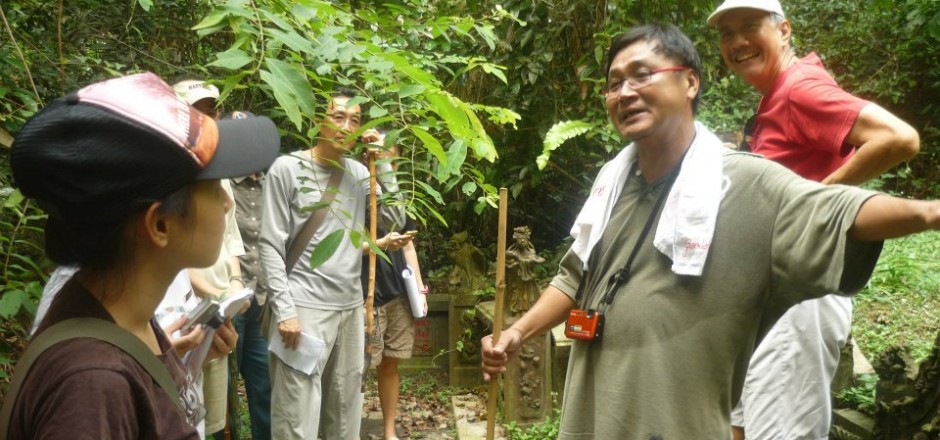
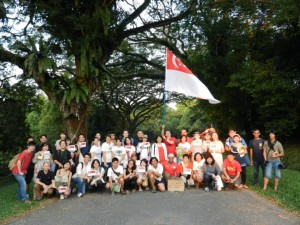

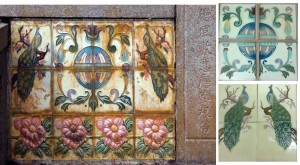
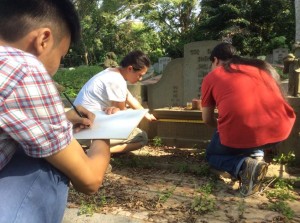
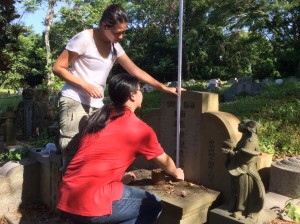


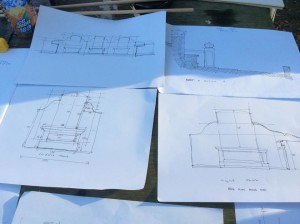
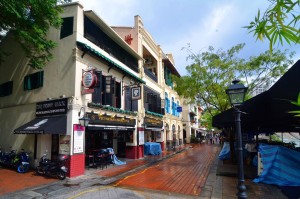

Recent Comments